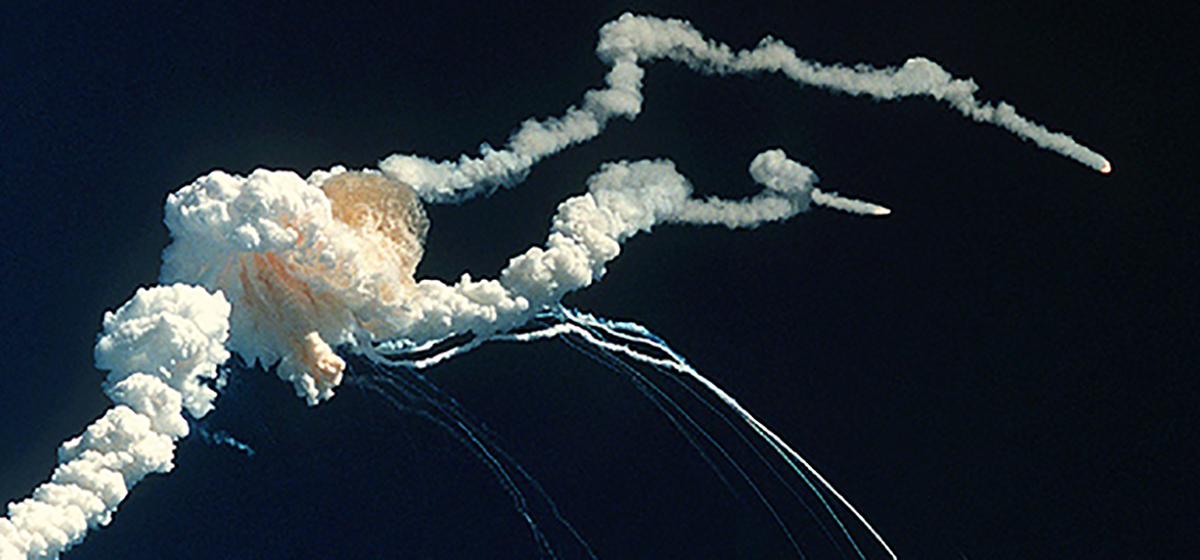At 11:35 a.m. EST on January 28, 1986, the Space Shuttle Challenger and its seven-member crew idled expectantly on a launch pad in Cape Canaveral, Florida. Named after an 1870’s era British naval research vessel, the almost three-year-old, re-usable winged spaceship had already flown 9 successful missions totaling nearly 24 million miles over the course of 62 days, orbited the earth nearly 1,000 times, and carried 53 astronauts into space and returned them safely home.
The Shuttle, external tank, solid rocket boosters and fuel weighed 4.4 million pounds. The craft consisted of 2.5 million parts, including more than 230 miles of wire, 1000 plumbing valves, and 27,000 insulating tiles and thermal blankets.
Tens of thousands of people were directly involved in implementing the space program, producing the Shuttle, and actuating this particular $450 million launch.
And, primarily due to excitement related to Sharon Christa McAuliffe’s selection from among 11,000 applicants to be the first member of the “Teacher in Space Project” to fly in space, tens of millions of people of all ages were watching the launch live via television.
Then, within minutes, the Shuttle successfully blasted off, traveled nine miles high and reached nearly twice the speed of sound.
But, evidence of a problem appeared just 0.7 seconds into the flight when a small puff of grey smoke spurted from a joint on one of the solid fuel rocket boosters.
Subsequent black smoke and a small steady flame at that location 59 seconds into the flight indicated that one of the O-rings had not formed a complete seal, which allowed pressurized hot gas to escape from within the motor and reach the outside tank and hardware, which led to structural failure and aerodynamic compromise of the craft approximately 73 seconds after liftoff.
As the Challenger broke apart, pieces continued upward to a peak altitude of 65,000 feet.
The intact crew cabin arced through space for an additional 2 minutes and 45 seconds, and crashed into the surface of the Atlantic Ocean at an unsurvivable force of 200 G’s and more than 200 mph.
It took six weeks to locate the crushed crew compartment in 100 feet of water, and a total of seven months, more than 50 aircraft and 6,000 people to search for shuttle pieces across a 480 nautical mile debris field.
For more than a decade, Challenger wreckage continued to wash up on Florida shores.
Ultimately, it was determined that a lower than optimum performance 36 degree F ambient air temperature at the time of the launch contributed to circumstances that helped create a functional gap difference of .004 inches in the single failed O-ring component that initiated this defining event in American history.
0.004 inches.
Like many, I clearly remember where I was and what I was doing the moment I heard about the Challenger disaster. My mother, a teacher, had applied for the competition, and we were all heartbroken over the death of McAuliffe and the crew. I also remember thinking that the O-ring, although just one of millions of components in the Shuttle system, was obviously a big thing.
Similarly, many people remember or have heard about the assassination of John F. Kennedy on November 22, 1963.
Lesser known is that during the 1960 Presidential election Kennedy squeaked out a nearly infinitesimal, but uniquely historical, victory over Richard M. Nixon of a mere 0.1 percent.
Close finishes in sports are perhaps less historically dramatic, but can also have huge consequences.
A swimmer friend of mine competed successfully and trained unremittingly for years in a bid to represent the United States in the 1988 Summer Olympics. But, he missed making the Olympic team by 1/100th of a second, and that loss heralded the end of his Olympic aspirations and swimming career.
Years later, eventually the most decorated Olympian ever at the time – American swimmer Michael Phelps – won his seventh gold medal of the 2008 Olympic Games in the men’s 100-meter butterfly by setting an Olympic record and beating his nearest competitor . . . by 1/100th of a second.
Conversely, during the 2012 Summer Olympics, the 100 meter freestyle world champion – Australian James “The Missile” Magnussen – lost his bid to win the first Aussie Olympic gold in the event since 1968 when he was defeated by American Nathan Adrian . . . by 1/100th of a second.
Amazingly, today’s cameras used in a variety of sports include photo finishes in brackets of 10,000 frames per second. Though that one increment of a second is a little thing, the difference can significantly impact advancement, career direction, historical import, money, motivation, opportunity, relationships, and much more.
Biologically, compared to humans, mosquitoes seem trivial. The insects live anywhere from weeks to a few months, are very small in length, and weigh less than teeny leaves or small pieces of tissue paper – 0.000088 oz (2.5 mg). Yet, approximately one half of the world’s population is at risk of contracting malaria from a single mosquito bite, an estimated 200 million people are infected annually, and hundreds of thousands of people die every year – including a malaria-related African death rate of one child per minute at one time.
However, since the type of mosquitoes that carry malaria primarily come out at night while people are sleeping, a global effort since 2000 to distribute insecticide-treated bed nets has reduced malaria cases worldwide by more than 60% and saved an estimated 700 million lives just in Africa over fifteen years.
In many areas of life, little things are really big things.
Jesus’ parable of the talents recorded in Matthew 25:14-28 and Luke 19:12-27 includes a master commending faithful servants.
“You have been faithful with a few things,” he says, “I will put you in charge of many things.”
Similarly, in the parable of the shrewd manager recorded in Luke 6:1-12, Jesus notes, “Whoever can be trusted with very little can also be trusted with much, and whoever is dishonest with very little will also be dishonest with much. So if you have not been trustworthy in handling worldly wealth, who will trust you with true riches?”
Small behaviors lead to big behaviors.
Same character, bigger stage.
It is no surprise that people who flirt with arrogance, bullying, cheating, duplicity, immorality, lying, mockery, stealing – and get away with such – often continue and increase in these behaviors.
Even when caught, if transgressors can convince themselves that their behavior was in some way acceptable, or not really that bad, or basically someone else’s fault, or “deserved” as compensation for something they did not have but wish they had or believed they merited, they will usually multiply in frequency and/or severity their unrighteous practice(s).
Repeat offenders often repeat their offenses because they are acting in accord with their character, experience, and training.
Similarly, people who evidence commitment, integrity, honesty and responsibility – even if no one else knows about their actions – tend to repeat their non-offenses because they, too, are acting in accord with their character, experience, and training.
Little incidents add up. What happens when someone is given too much money, is in communication with a person they find attractive or unattractive, is privy to gossip, or walks by a piece of trash, a stray piece of clothing, or an unfinished task?
How does one treat clerks and servers, animals, kids, old people, rich people, powerful people, other cultures and races, sinners and saints, simpletons and intellectuals, rival fans and competitors?
Most telling is what people say and do in private when they think no one is listening or looking, or perhaps when collaborating with a like-minded person or group.
What is or is not selected to view in print, online, or on TV? What public and private files and items are kept or thrown away? What games are played, or not? What activities are conducted in secret? What words are whispered? What godly opportunities or evil temptations are entertained, explored, or engaged?
Small, private actions can help envisage the future public actions of both heroes and villains. Little things are often windows to the mind and soul, glimpses into eternity, and doors to opportunity. They are seeds of larger realities that far surpass their tiny present. What they whisper in micro, they shout in macro. Tiny evidence can lead to gigantic truth. Small words can bring down big people or lift up little people.
Certainly, little things can be momentary, fleeting, and mostly inconsequential. But, when they are integral components connected to a larger whole, a unit, a team, a complex system, a mission, a season, a life, an eternity – little things can be very, very, very BIG things.





